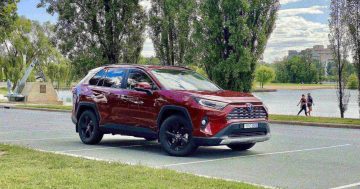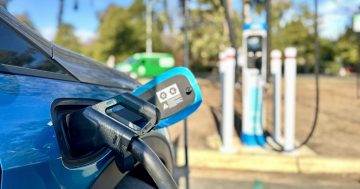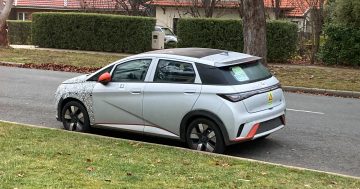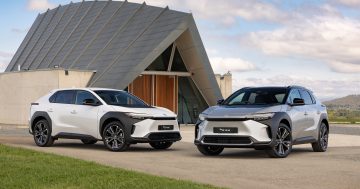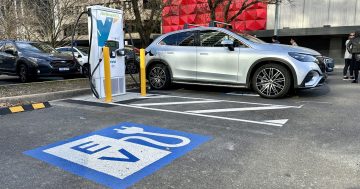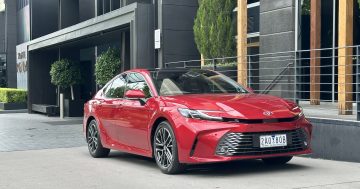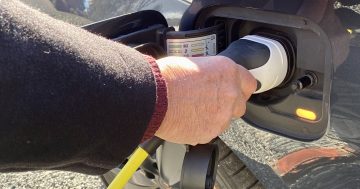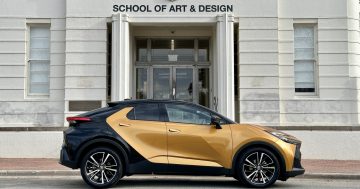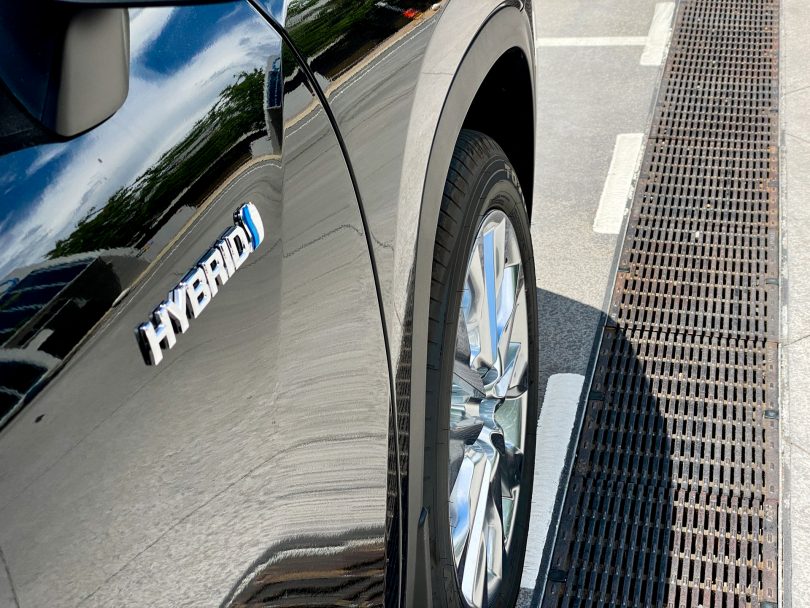
A hybrid blends a petrol engine with an electric motor. Photo: James Coleman.
The ACT might have the highest number of electric vehicles per capita of any state or territory, but they made up just over 1 per cent of new car sales so far this year.
Upfront cost may be one reason people aren’t rifling through the couch cushions for the cash to buy an EV just yet, but Australia’s ‘boundless plains’ certainly don’t help.
Canberra to Melbourne? It’ll take a lot longer than seven hours (even including rest time).
Couple the sheer distances with a dismal number of public charging stations and the life of an EV owner at the moment can begin to look quite inconvenient.
Could the ‘hybrid’ be a safer bet for the here and now?
Canberra Toyota Dealer Principal Mirko Milic says the now rampant technology represents a best-of-both-worlds solution to Australia’s current EV situation.
“If you don’t want the hassle of not being able to drive to Sydney and back in a day without stress, you go hybrid. You’re still saving fuel and making a reduction in your emissions,” he says.

Under the bonnet of the Toyota Kluger Hybrid. Photo: James Coleman.
The Canberra market seems to agree too, with 8.6 per cent of the cars sold between January and November this year fitting under the hybrid umbrella.
The Japanese car brand Toyota pioneered fitting an electric motor alongside a standard internal-combustion engine as far back as 1997. The result was the Prius – the world’s top-selling hybrid with total sales worldwide of more than 4 million units.
Since then, the Toyota boffins have continued to polish and perfect the technology to the point that now, not only is it hard to find a model in their range that isn’t available as are stila hybrid, but it’s also nigh impossible to spot the moment the petrol engine kicks in.
Hybrids start purely under electrical power, which for me – at the wheel of the new, hefty, seven-seat Kluger Hybrid – translates to an uncanny turn of speed. Plant your foot or exceed 40 km/h and only then will you detect a bit of noise coming from the front.

The new seven-seat Toyota Kluger Hybrid, in top-of-the-range ‘Grande’ form. Photo: James Coleman.
Deploy the brakes or cruise down a hill and the energy that would usually be lost in heat and noise is diverted to charge the battery.
“Nothing is wasted,” Mirko says. “It is constantly harvesting everything.”
Even if you can’t feel it, you can see all this happening. The Kluger Hybrid swaps a conventional rev counter for a dial divided into three sections, one blue, one green and the largest is white. The needle is in the blue segment when the battery is being charged, in the green when only electricity is involved, and white once the petrol engine chimes in.
Toyota owns up to 90 per cent of the hybrid market, followed by its posher sibling, Lexus. But another type of hybrid, primarily produced by Mitsubishi, takes the concept a step closer to electric vehicles.

The Kluger’s ‘EV Mode’ tries the keep the petrol engine off for as long as possible. Photo: James Coleman.
A Plug-in Hybrid Electric Vehicle (PHEV) is equipped with a larger electric motor and battery pack, good for up to 100 km of pure electric range before the petrol engine has to think about starting. As the name suggests, a PHEV can also be plugged into a wall to recharge.
While a conventional hybrid system like the one in the Kluger is touted to almost halve the bill at the bowser, a plug-in hybrid could see a single tank of fuel last for weeks as you gad about town with daisies popping up out of the exhaust pipes.
Toyota might have a grand total of zero fully electric cars in their current range, but there are ambitious plans afoot to have up to 70 models as soon as 2025. However, in times past, they have seemed to adopt a more ‘steady on’ approach when it comes to EVs.
For instance, they have argued that when you take the whole lifecycle of an EV into consideration, from the mining of the materials used in the battery to the recycling of those same materials later on, a hybrid can, in fact, return a lower life cycle emissions figure.
“EVs won’t really win the race until there is more renewable energy, and we’re talking a heck of a lot more renewable energy,” Mirko says.

Seeing eye to eye. Photo: James Coleman.
Hybrids might be beginning to make an awful lot of sense at this point, but there is a catch.
The petrol Kluger Grande comes in at about $69,000 before on-road costs, whereas my hybrid starts from $75,000.
In a double whammy, this also enters the realms of Luxury Car Tax (LCT), which also means the ACT’s stamp-duty exemption vaporises. This exemption is only in place for those green vehicles that come in under the LCT threshold.
Nevertheless, Mirko says the price difference continues to drop as time goes on and that if you play your cards right, the difference can be as little as $1,500 for the Camry and Corolla models. As for life after that, the Kluger Hybrid consumes a claimed 5.6 litres of fuel every 100 km, just over half the petrol model. That’ll pay for itself fairly quickly … and you don’t have to carry an extension cord.

The Grande scores plenty of leather and wood inside. Photo: James Coleman.
2021 Toyota Kluger Grande Hybrid
- $79,182 driveaway
- 2.5-litre inline-4 and electric motor, 184 kW combined
- Continuously Variable Transmission (CVT), all-wheel drive (AWD)
- 5.6 litres / 100 km (95 RON)
- 5-star ANCAP safety rating.












